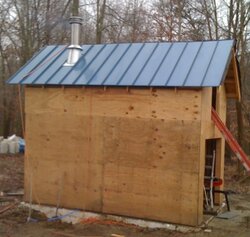I plan to install my Econoburn 150 in my modern steel construction barn and run my heating line about 60' underground to my house. I got a good buy locally on a bunch of used 8 inch stainless steel double-insulated Selkirk Metalbestos pipe. My first thought is to run my flue pipe through the wall and up the out side of the barn, but the braces, bands, and tee will cost me about $400. I think it would be cheaper for me to just go straight up through the metal roof, but the roof is the modern "corrugated" sheet metal type and i'm wondering what I would use for a roof flashing/collar. Has anyone ever seen one made for a roof other than the standard shingle type flashing?
Also, Ace Hardware online seems to have cheapest prices on the Selkirk Metalbestos piping and accessories. This includes the vendors on eBay. Does anyone know any other vendors who might be a good source for these materials? As always, thanks for your help and ideas!
Also, Ace Hardware online seems to have cheapest prices on the Selkirk Metalbestos piping and accessories. This includes the vendors on eBay. Does anyone know any other vendors who might be a good source for these materials? As always, thanks for your help and ideas!


